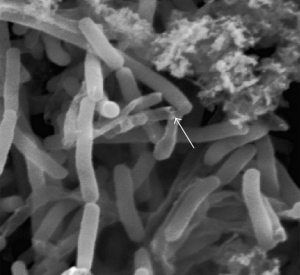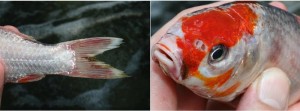
Also known as Cottonmouth, Fin Rot, Tail Rot or Saddleback disease, Flavobacterium columnare is a rod-shaped Gram-negative, aerobic bacterium.
Although Columnaris infections aren’t commonplace, they have a high mortality rate. There are horror stories of enthusiasts losing their entire pond overnight. And it can spread quickly in water with higher temperatures.
Like Aeromonas (which we recently discussed), Columnaris exists in all pond water. It is as much a part of your pond as hydrogen and oxygen. In short, you’re stuck with it.
And much like Aeromonas, Columnaris infections occur in high-stress environments. It is also an opportunistic pathogen and needs a convenient entryway into its host. Most frequently this happens through open wounds.
In the right environment the damage from Columnaris quickly spreads. The more virulent strains can kill a koi in a matter of hours.
It has also been demonstrated that hard water (water with higher mineral concentrations) contributes to greater Columnaris growth.
Appearance
Here are some of the signs that your koi have a columnaris infection:
- The fins and tail will take on a ragged look, either looking shredded or bitten.

Sunken eyes and dead tail tissue as a result of Columnaris infection. - The pectoral and caudal fins will be “clamped” or held closely in to the body.
- The eyes may be sunken into the head.
- Sores or lesions will develop on the body. Initially they will appear to be small areas where the sheen has been stripped away. These eventually become open ulcers.
- A lesion around the dorsal fin is common. Its location in the middle back and banding around the fish gives it a saddle-like appearance (hence Saddleback disease).
- The koi can also develop a white milky sheen in patches over the body. This is commonly misdiagnosed as a fungal infection. However, it is the result of a fish’s body overproducing the protective slime coating, in response to the infection.
- Discolored mucous can be seen in or around the mouth (hence cottonmouth), eyes and on the head and dorsal regions.
- Gills will become discolored, taking on a brown color.
Symptoms
- You may notice that your koi has a hard time breathing and will breath rapidly. This is a result of the infection eroding the gill filaments.
- The koi will be lethargic and lose its appetite, which can result in rapid weight loss.
- It will spend a lot of time near the surface of the water or alternatively spend periods resting on the bottom of the pond.
- You might see it flashing occasionally or rubbing itself on the side of the pond or tank.
Causes
As we noted previously, a pond with stress-causing conditions is more conducive to a Columnaris infection. Some of the factors that can lead to a Columnaris infection are:
- Heavy Bioload — overcrowding can lead to poor water quality.
- Uneaten food — Columnaris has been seen to grow on uneaten food so make sure to feed proper amounts, and especially at higher temperatures.
- Low oxygen — low dissolved O2 levels are also believed to contribute to a favorable environment for the bacteria to flourish.
- High nitrite and ammonia concentrations — this follows from poor water conditions caused by undigested food and excess waste.
- Rough handling — netting and rough handling or stress from moving can all provide the convenient means of entry for the Columnaris bacteria.
- Shipping stress — an abnormally rough transit during shipping can sometimes lead to a columnaris outbreak
Keeping your ratio of koi to healthy levels in your pond can’t be stressed enough. Higher bioloads mean more waste, often poorer water conditions and the capacity for more stress on your koi.
Treatment
Ideally, prevention is better than the cure. A pond that offers minimal stress can go a long way in reducing a Columnaris infection. However, should an infection be discovered, here are some steps to take.
- Any fish that you discover with columnaris type symptoms need to be quarantined immediately.
- A salt bath can help to stop Columnaris too, sometimes with as little as a 0.5% solution.
- If an infection is diagnosed, changing the water (anywhere from 30-50%) is recommended as it spreads rapidly through the water column. When changing the water, take the opportunity to clean the gravel or whatever material you have on the pond floor to remove as much waste as possible.
- Medications with nitrofurazone as the active ingredient are highly effective in stopping the infection
- An oxytetracycline bath is a secondary treatment option
- Hydrogen peroxide is good for treating external infections, too.
Because of its white, milky fungus-like appearance, Columnaris is often misdiagnosed. Anti-fungals will have no effect whatsoever on your infected koi.
Whatever medication you opt for, finish the course so as to limit the potential for resistant strains down the road. Also, make sure that all tanks used for quarantine are thoroughly cleaned as it is highly contagious.
It is important to consider the condition of the koi you are treating, too. It will determine what strength and duration of treatment it will be able to take.
Quality koi fish dealers observe stringent quarantining procedures to ensure that their koi are free of any infections or illnesses before they are put on sale. At Next Day Koi, all of our koi fish for sale undergo a 14-day quarantine period in separate holding facilities during which time they are closely monitored for any signs of infection or health issues.

You not only sell gorgeous fish you provide alot of usefull information.
Hi John. Thank you for the great feedback. Let us know if you have any ideas for a new article. Thanks again!
[…] Source: 🔗 […]